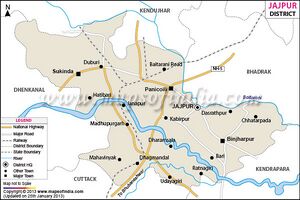Jajpur
| Author:Laxman Burdak, IFS (R) |

Jajpur (जाजपुर) is a city and a district in the Indian state of Odisha. It was the capital of Odisha during the Kesari dynasty, later supplanted by Cuttack.[1]
Variants
- Virajakshetra विरजाक्षेत्र दे. Yajnapura यज्ञपुर ((AS, p.861)
- Jajanagara जाजनगर = Yajnapura यज्ञपुर ((AS, p.362)
- Jajapura/Jajapur जाजपुर = Yajnapura यज्ञपुर ((AS, p.362)
- Yajnapura यज्ञपुर = Jajapura जाजपुर = Jajanagara जाजनगर, उड़ीसा, (AS, p.768)
- Yagyapura यज्ञपुर
- Jajnagar
- Viraja
- Viranja
- Varanja-nagara
- Varaha-tirtha/Varaha Tirtha (वाराह तीर्थ) (III.81.15),
- Yajanagara
Etymology and names
Jajpur, the location of the ancient Viraja Temple, was originally known as Viraja. Other names of the city in the ancient texts include Viranja, Varanja-nagara, Varaha-tirtha.[2] The Bhauma-Kara kings established their capital city of Guhadevapataka (or Guheshvarapataka), identified with modern Gohiratikar (or Gohiratikra) near Jajpur.[3] The later Somavanshi kings moved their capital from Yayatinagara (modern Binka) to Guheshvarapataka, and renamed the city Abhinava-Yayatinagara ("the new city of Yayati").[4]
Later, the Jajpur city came to be known as Yajanagara. According to one theory, this name is a corruption of "Yayatinagara". Another theory is that it derives from the Brahmanical sacrifices (Yajna) that became popular during the Ganga-Gajapati period (11th-16th century).[5] In the Muslim chronicles such as Tabaqat-i-Nasiri[6] and Tarikh-i-Firuzshahi, the city's name was mentioned as "Jajnagar". Later, the suffix "-nagar" ("city") was replaced with the equivalent "-pur", and the city's name became "Jajpur".[7]
Jat clans
Barojwar (बरोजवार) gotra of Jats is said to be started from their ancestral king Biraja (बिरजा) or Viraja (विरज) of Nagavansh. [8] Viraja (विराज) was a Nagavanshi King of the period of Mahabharata.
History
Earliest account of Jajpur is part of the history of the Odisha. It was the capital of Keshari King Yayati Keshari in 473 CE.[9] Accounts by Chinese travelers mention Jajpur as capital in 7th century. It has been a center of Tantrism. The budhhist kingdom of Bhauma Karas also kept Jajpur as their capital in 8th century CE. Many Buddhist structures have been unearthed in and around Jajpur that point to the Buddhist past of the town.[10][11]
In Mahabharata
Varaha Tirtha in Mahabharata (वाराह तीर्थ) (T) (III.81.15),
Vana Parva, Mahabharata/Book III Chapter 81 mentions names of Tirthas (Pilgrims). Varaha Tirtha (वाराह तीर्थ) is mentioned in Mahabharata (III.81.15).[12]....one should next proceed to the excellent tirtha called Varaha Tirtha (वाराह तीर्थ), where Vishnu formerly stood in the form of a boar. Bathing there one obtaineth, O foremost of men, the merit of the horse-sacrifice.
यज्ञपुर = जाजपुर = जाजनगर
विजयेन्द्र कुमार माथुर[13] ने लेख किया है ...यज्ञपुर = जाजपुर = जाजनगर (AS, p.768) उड़ीसा के जाजपुर ज़िले में वैतरणी नदी के तट पर स्थित यह एक प्राचीन स्थल है। प्राचीन समय में यह यज्ञपुर, जाजपुर के नाम से जाना जाता था। महाभारत में इस क्षेत्र को विरजा क्षेत्र कहा गया है। दूसरी-तीसरी सदी ई.में यह क्षेत्र एक तीर्थ स्थल के रूप में माना जाता था। कहा जाता है कि इस नगर की स्थापना छठी सदी में उड़ीसा के राजा ययाति केसरी ने की थी। विरजा ययाति की इष्टदेवी थी। यहाँ पर एक मंदिर में विरजा (वि-रजा=रजोगुणहीन) देवी की मूर्ति स्थापित की है। यहाँ से प्राचीन विशालकाय प्रतिमाएँ मिली हैं। इनमें से एक 16 फुट ऊँची बोधिसत्व पद्मपाणि की प्रतिमा है। अन्य प्रतिमाएँ चामुण्डी,वराही एवं इन्द्राणी की हैं। ये काफ़ी क्षतिग्रस्त हैं। युवानच्वांग के समय जाजपुर ही उड़ीसा की राजधानी थी। मालवा के सुल्तान हुसंगशाह ने जाजनगर पर 1421 ई. में आक्रमण किया था।
External links
References
- ↑ Rout, K.C. (1988). Local Self-government in British Orissa, 1869-1935. Daya Publishing House. p. 35. ISBN 978-81-7035-046-0.
- ↑ Thomas E. Donaldson (2001). Iconography of the Buddhist Sculpture of Orissa. Abhinav. ISBN 978-81-7017-406-6., p. 51
- ↑ Thomas E. Donaldson 2001, p. 6.
- ↑ Thomas E. Donaldson 2001, p. 51.
- ↑ Kailash Chandra Dash (2010). "A traditional account on Yayati Keshari: Its formation and historical authenticity". Proceedings of the Indian History Congress. 71 (2010–2011): 165–178. JSTOR 44147485. p. 169.
- ↑ The history of India : as told by its own historians. Volume II/VIII. Tabakat-i Nasiri of Minhaju-s Siraj,p.314
- ↑ Thomas E. Donaldson 2001, p. 51.
- ↑ Mahendra Singh Arya et al.: Ādhunik Jat Itihas, Agra 1998, p. 269
- ↑ Asiatic Society (Calcutta, India); Asiatic Society of Bengal (1871). Journal of the Asiatic Society of Bengal. Bishop's College Press. p. 151.
- ↑ Rout, K.C. (1988). Local Self-government in British Orissa, 1869-1935. Daya Publishing House. p. 35. ISBN 978-81-7035-046-0.
- ↑ Deshpande, A. (2013). Buddhist India Rediscovered. Jaico Publishing House. p. 245. ISBN 978-81-8495-247-6.
- ↑ 15 ततॊ गच्छेत धर्मज्ञ वाराहं तीर्थम उत्तमम, विष्णुर वाराह रूपेण पूर्वं यत्र सथितॊ ऽभवत, तत्र सनात्वा नरव्याघ्र अग्निष्टॊम फलं लभेत (III.81.15)
- ↑ Aitihasik Sthanavali by Vijayendra Kumar Mathur, p.768

